Harris C.M., Piersol A.G. Harris Shock and vibration handbook
Подождите немного. Документ загружается.


COMPRESSION SET AND CREEP
Dimensional stability is necessary for vibration isolators and dampers that function
under applied loads, i.e., the static deflection of an isolator should not increase with
time. Such an increase is a result of creep and compression set. Compression set is
the change in dimension with an applied strain; creep is the change in dimension with
an applied force. Compression set and excessive creep will induce a large change in
stiffness and dynamic properties over a period of time. Compression set is deter-
mined by compressing a specimen (of specified size) to a preset deflection and
exposing it to an elevated temperature.
11
After exposure the specimen is allowed to
recover for one-half hour and the thickness is measured. Percent compression set is
the decrease in thickness divided by the original deflection and multiplied by 100.
Typical rubber compounds used for vibration isolation have compression set values
of from 10 to 50 percent. The exposure time is usually 22 or 70 hours at a tempera-
ture relevant to the intended use of the isolator or damper. Creep is determined by
placing a specimen in a compression device, applying a compressive force, and
exposing it to an elevated temperature.
12
Percent creep is the decrease in thickness
divided by the original thickness and multiplied by 100.
ADHESION
Adequate rubber-to-metal adhesion is imperative in the fabrication of most vibra-
tion isolators and dampers. Adhesive is first applied to the metal; then the rubber is
bonded to the metal during vulcanization. Various adhesives are available for all
types of elastomers. In testing for adhesion, a strip of rubber is adhered to the face
of a piece of adhesive-coated metal.
13
After vulcanization (and possible aging), the
rubber is pulled from the metal at an angle of 45° or 90°, and the adhesion strength
is measured. The mode of failure is also recorded.
Another ASTM method
14
is used to determine the rubber-to-metal adhesion
when the rubber is bonded after vulcanization, i.e., for postvulcanization bonding. In
this procedure a vulcanized rubber disk is coated on both sides with an adhesive and
assembled between two parallel metal plates. Then the assembly is heated under
compression for a specified period of time. The metal plates are then pulled apart
until rupture failure.
LOW-TEMPERATURE PROPERTIES
Rubber becomes harder, stiffer, and less resilient with decreasing temperature.
These changes are brought about by a reduction in the “free volume” between
neighboring molecules and a subsequent reduction in the mobility of the elastomer
molecules. When approaching the glass transition temperature (T
g
), its rubber-like
characteristic is lost and the rubber becomes leathery. Finally it changes to a hard,
brittle glass. The glass transition temperature is a second-order transition as
opposed to crystallization, which is a first-order transition. A first-order transition
is accompanied by a abrupt change in a physical property, while a second-order
transition is accompanied by a change in the rate of change. The glass transition
temperature can be detected by differential scanning calorimetry or changes in
static or dynamic mechanical properties.This is described in the section on dynamic
properties of rubber.
33.8 CHAPTER THIRTY-THREE
8434_Harris_33_b.qxd 09/20/2001 12:30 PM Page 33.8

The effect of temperature on stiffness is measured using a Gehman apparatus.
15
It provides torque to a strip of rubber by a torsion wire. The measurement is first
made at 23°C and then at reduced temperatures. The relative modulus at any tem-
perature is the ratio of the modulus at that temperature to the modulus at 23°C. The
results are expressed as the temperatures at which the relative moduli are 2, 5, 50,
and 100. Figure 33.2 shows the effect of temperature on the relative torsional modu-
lus of various elastomers.
16
Young’s modulus can also be measured at low tempera-
ture using a flexural procedure.
17
HIGH-TEMPERATURE PROPERTIES
Some vibration isolators and dampers function in high-temperature environments.
The rubber compounds used in these applications must have resistance to high-
temperature degradation. The stability at high temperatures is related to the chemi-
cal structure of the elastomer and the chemical cross-linking bonds formed during
vulcanization. Elastomers containing no unsaturation (chemical double-bonds) in
the backbone have better high-temperature properties. Rubber compounds con-
taining EPDM, for example, have better high-temperature resistance than ones con-
taining natural rubber or SBR. In a sulfur cure, mono or disulfide cross-linking
bonds have better high-temperature stability than polysulfide bonds. Cure system
modifications are therefore used to improve high-temperature stability.
The high-temperature resistance of rubber compounds is determined by measur-
ing the percentage of change in tensile strength, tensile stress at a given elongation,
and ultimate elongation after aging in a high-temperature oven as per ASTM pro-
cedure.
18
OIL AND SOLVENT RESISTANCE
Some vibration isolators and dampers, particularly those used in automotive prod-
ucts, have contact with oils or solvents. The effect of a liquid on a particular rubber
depends on the solubility parameters of the two materials. The more the similarity,
the larger the effect.A liquid may cause the rubber to swell, it may extract chemicals
from it, or it may chemically react with it. Any of these can lead to a deterioration of
the physical properties of rubber. The effect of liquids on rubber is determined by
measuring changes in volume or mass, tensile strength, elongation, and hardness
after immersion in oils, fuels, service fluids, or water.
19
EXPOSURE TO OZONE AND OXYGEN
Ozone is a constituent of smog; in some areas, ozone may occur in concentrations that
are deleterious to rubber. Vibration isolators and dampers also may be exposed to
ozone generated by the corona discharge of electrical equipment. Elastomers contain-
ing unsaturation in their backbone structure are especially prone to ozone cracking,
since ozone attacks the elastomer at the double bonds. Elastomers such as NR, SBR,
BR, and NBR have poor resistance, while EPDM and GPO have excellent resistance
to ozone cracking. Ozone cracking will not occur if the rubber is unstrained. There is a
critical elongation at which the cracking is most severe.These strains are 7 to 9 percent
for NR, SBR, and NBR, 18 percent for CR, and 26 percent for IIR.
20
Both static
21
and
MECHANICAL PROPERTIES OF RUBBER 33.9
8434_Harris_33_b.qxd 09/20/2001 12:30 PM Page 33.9

dynamic
22
testing procedures are used. In the static test the sample is given a specified
strain. Results are expressed as cracking severity using arbitrary scales or as time until
first cracks appear. In Method A, the dynamic procedure tests strips of rubber in ten-
sion at 0.5 Hz. Method B adheres the test strips to a rubber belt that is rotated around
two pulleys at 0.67 Hz. The number of cycles to initial cracking is reported.
DYNAMIC PROPERTIES
VISCOELASTICITY
Rubber has elastic properties similar to those of a metallic spring and has energy-
absorbing properties like those of a viscous liquid.
23
These viscoelastic properties
allow rubber to maintain a constant shape after deformation, while simultaneously
absorbing mechanical energy. The viscosity (which varies with different elastomers)
increases with reduced temperature. The elasticity follows Hooke’s law and in-
creases with increased strain, while the viscosity follows Newton’s law and increases
with increased strain rate. Therefore, when applying a strain, the resultant stress will
increase with increasing strain rate.
Springs or dashpots are frequently used to make theoretical models which illus-
trate the interaction of the elastic and viscous components of rubber. The springs
and dashpots can be combined in series or in parallel, representing the Maxwell or
Voigt elements (see Table 36.2). Rubber actually consists of an infinite number of
such models with a wide spectrum of spring constants and viscosities.
MEASUREMENT OF DYNAMIC PROPERTIES
Resilience, measured by several relatively simple tests, is sometimes used for esti-
mating the dynamic properties of a rubber compound. In these test methods a strain
is applied to a rubber test sample by a free-falling indentor. Resilience is defined as
the ratio of the energy of the indentor after impact to its energy before impact
(expressed as a percentage). Two widely used methods include the pendulum
24
and
the falling weight methods.
25
Although resilience is a crude measurement of the
dynamic properties of rubber, it is attractive because of its simplicity and cost.
In free vibration methods, the rubber sample is allowed to vibrate at its natural
frequency.
26
To change the natural frequency the sample size or added weights must
be changed. Since it is a free vibration, the amplitude A decreases with each oscilla-
tion. Resilience is defined as A
3
/A
2
, expressed as a percentage.
In forced vibration methods, the dynamic properties (or viscoelasticity) of a rub-
ber compound are determined by measuring its response to a sinusoidally varying
strain.
27
In this manner, both the strain and the strain rate vary during a complete
cycle.The ratio of the energy dissipated in overcoming internal friction to the energy
stored is a function of the viscoelasticity of the rubber. In a simple apparatus for
measuring dynamic properties, a sinusoidally varying strain is applied to the sample
by means of a motor-driven eccentric. The resultant force is measured at the oppo-
site end of the sample with a dynamometer ring or electronic measuring device. The
angular distance between the input strain and the resultant stress is measured by
mechanical or electronic methods. A graph of the sinusoidal strain and resultant
stress, both plotted as a function of time or angle, is shown in Fig. 33.3.The measured
33.10 CHAPTER THIRTY-THREE
8434_Harris_33_b.qxd 09/20/2001 12:30 PM Page 33.10
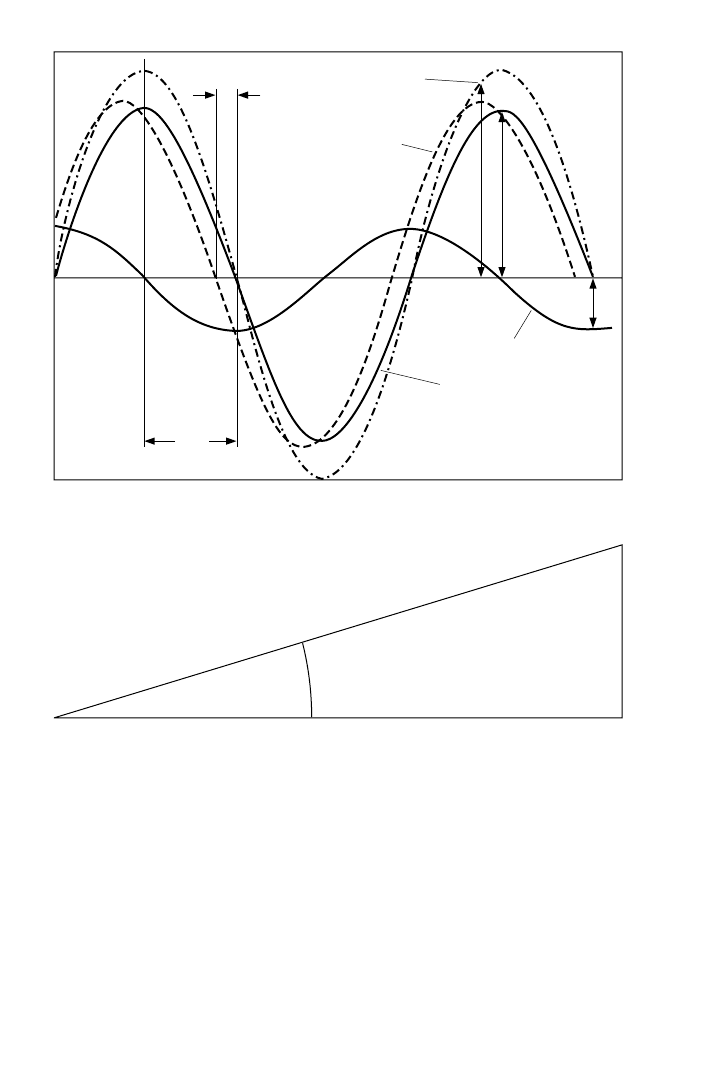
maximum stress amplitude precedes the maximum strain amplitude by the phase
angle δ.The stress amplitude (F
0
) is composed of contributions from both the elastic
stress (F
1
) and the viscous stress (F
2
). The amount contributed by each is a function
of the phase angle. Following Hooke’s Law, the resultant stress due to the elastic
portion of the rubber is in phase with, and proportional to, the strain. When the
imposed strain reaches a peak value, the resultant elastic stress also reaches a peak
value. The resultant stress due to the viscous portion of the rubber is governed by
Newton’s law and is 90° out of phase with the imposed strain. When the strain is at a
maximum value, the strain rate (slope of the strain curve) is zero. Consequently, the
resultant viscous stress is zero.At zero strain, the strain rate is at a maximum, and the
MECHANICAL PROPERTIES OF RUBBER 33.11
90°
Time (phase angle)
Elastic stress, F
1
; (E′)
Total (measured) stress, F
0
;
(E*, G*)
Viscous
stress, F
2
;
(E′′)
Stress or strain
Viscous stress
Elastic stress
Strain
Total stress
δ
δ
FIGURE 33.3 The applied sinusoidal strain and the resultant stress plotted as a function of time or
phase angle. The maximum elastic and viscous stress, and the elastic and viscous modulus values are
calculated using simple trigonometry. (After Schaefer.
23
)
8434_Harris_33_b.qxd 09/20/2001 12:30 PM Page 33.11

resultant viscous stress is at a peak value. The only values measured are the stress
amplitude and the phase angle δ. The complex modulus is calculated by dividing the
resultant maximum stress amplitude by the maximum imposed strain amplitude.
Both the maximum elastic stress amplitude and the maximum viscous stress ampli-
tude are calculated from the measured stress amplitude and the phase angle δ using
simple trigonometric functions. Dividing these stress values by the strain gives the
elastic modulus (E′) and the loss modulus (E″). Tan δ equals E″/E′. The value of tan
δ (the ratio of the viscous to the elastic response) is a measurement of damping or
hysteresis.
INFLUENCE OF COMPOUNDING INGREDIENTS
ELASTOMERS
The dynamic properties of an elastomer are determined by its glass transition tem-
perature (T
g
). Elastomers having the lowest T
g
will have the lowest tan δ (or highest
resilience). Natural rubber has a fairly low T
g
(−60°C) and thus has a low tan δ. Butyl
rubber has a low T
g
(−60°C), but the transition region extends above ambient tem-
perature. It consequently has a high tan δ and is frequently used in vibration damping
applications.The effect of temperature on the dynamic stiffness (dynamic spring rate)
and damping of compounds containing different elastomers is shown in Fig. 33.4.
CARBON BLACK
Carbon black has a major influence on the dynamic properties of compounded rub-
ber.
28
It is a source of hysteresis or damping. The amount of damping increases with
the surface area of the carbon black and the level used in the compound.
VIBRATION ISOLATION AND DAMPING
Dynamic properties, which are a function of the elastomer and other compounding
variables, determine the vibration isolation and damping characteristics of a rubber
compound. Springs and dashpots are used to describe how the viscoelastic proper-
ties relate to the vibration isolation and damping properties.
29
The quantity tan δ,
being the ratio of the viscous to elastic response, can be substituted for ζ=c/c
c
in the
equations for transmissibility derived in Chap. 2. Figure 33.5 summarizes the effect
of dynamic properties on transmissibility. Transmissibility curves of different com-
pounded elastomers are shown in Fig. 33.6.
30
The NR, EPDM, CR, and SBR rubbers
have low T
g
’s and therefore have low damping properties. As a result they have the
highest transmissibility at the resonating frequency and the lowest transmissibility at
higher frequencies.The opposite effect is seen with IIR and NBR, which have higher
damping properties. As shown in Fig. 33.7, increased levels of carbon black increase
damping and thus decrease the transmissibility at the resonance frequency.
Increased levels also increase the compound’s stiffness, with a resulting increase in
resonance frequency. For further information on the effect of viscoelastic properties
on vibration isolation and damping, see Refs. 31 and 32.
33.12 CHAPTER THIRTY-THREE
8434_Harris_33_b.qxd 09/20/2001 12:30 PM Page 33.12
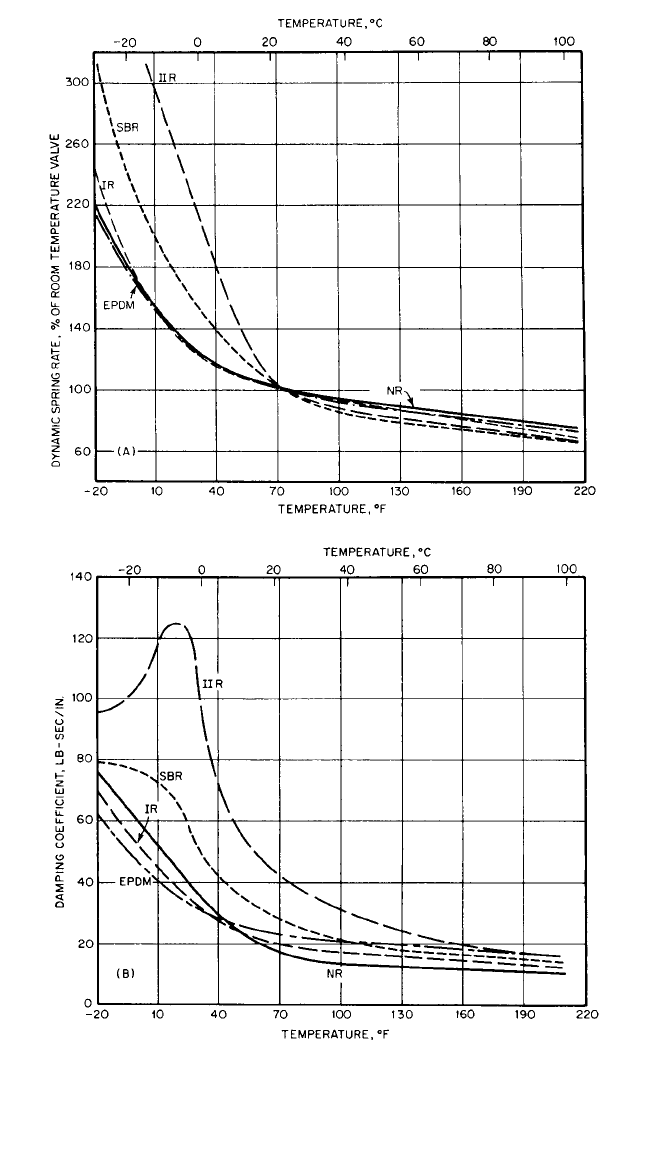
FIGURE 33.4 The effect of temperature on (A) the dynamic stiffness (spring rate)
and (B) the damping coefficient of typical isolating and damping compounds using
several elastomers.
33.13
(A)
(B)
8434_Harris_33_b.qxd 09/20/2001 12:30 PM Page 33.13
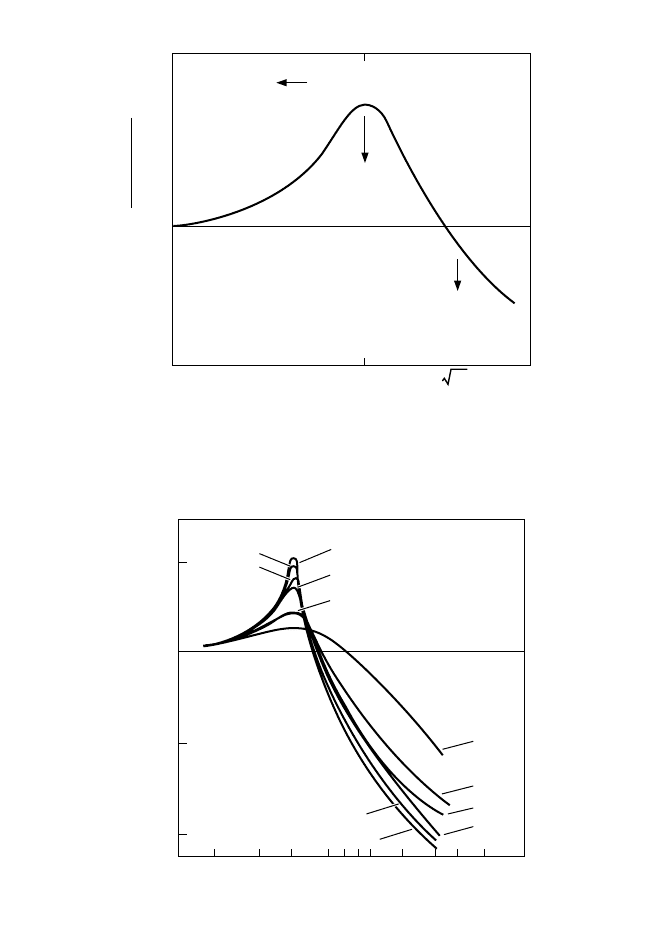
33.14 CHAPTER THIRTY-THREE
1.0
Transmissibility =
Output force
Input force
0 1.0
Frequency ratio, ω/ω
n
2.02
Magnification
region
Increased
damping (tan δ)
lowers peak
Minimum increase of
spring rate with
frequency improves
isolation
Lowering elastic modulus (E′)
moves curve to left
Attenuation
region
FIGURE 33.5 The effect of the dynamic properties of rubber on
the transmissibility curve. (After Edwards.
29
)
Log transmissibility, dB
0.1 0.2 0.5 1 2 3 4 5 10 20 30 50
Frequency ratio, ω/ω
n
+20
0
EPDM
SBR
IIR
NR
CR
–20
–40
NBR
IIR
CR
NR
EPDM
SBR
FIGURE 33.6 The dependence of transmissibility on the type
of rubber used for the mounting. (After Freakley.
30
)
8434_Harris_33_b.qxd 09/20/2001 12:30 PM Page 33.14
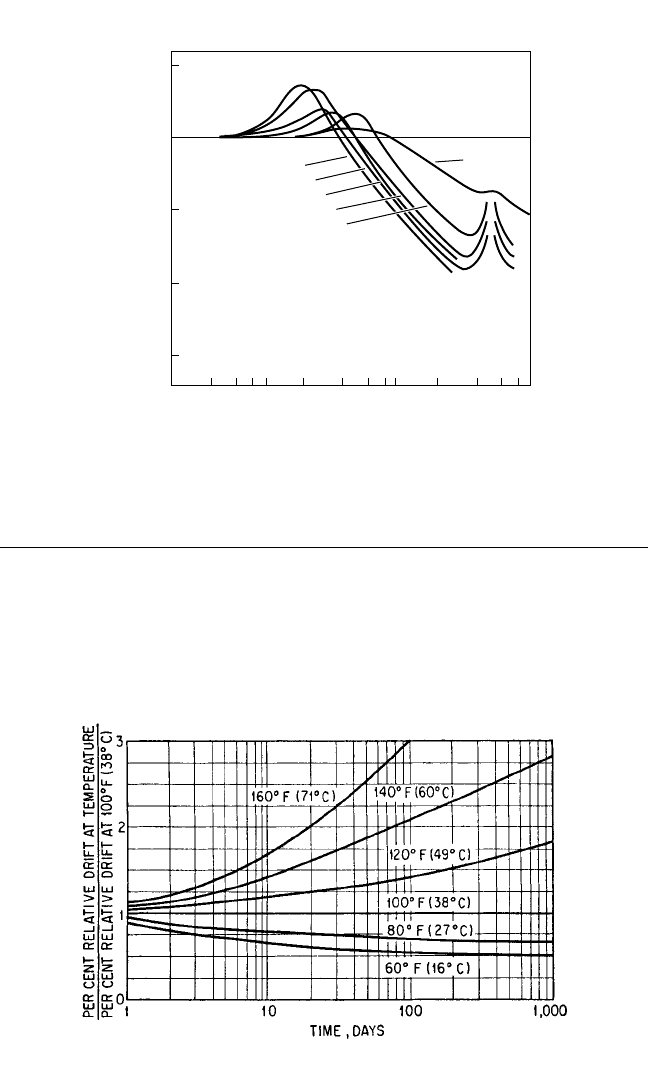
FATIGUE FAILURE
Rubber shock and vibration isolators and dampers fail in service due to either exces-
sive drift (creep) or mechanical fracture as a result of fatigue. Static drift or set test-
ing is described above in the section on compression set. The effect of temperature
on the drift of a natural rubber compound is shown in Fig. 33.8.
33
The drift properties
of rubber can be tested using static or dynamic methods.
MECHANICAL PROPERTIES OF RUBBER 33.15
Log transmissibility, dB
10
20
40
50
200
100
300
500
2
000
4
000
+20
0
1
15
Carbon black
parts per
100 parts of
natural rubber
35
60
80
NBR
30
1000
–40
–20
–60
FIGURE 33.7 The dependence of transmissibility-frequency
curves on the level of carbon black in natural rubber compounds.
(After Freakley.
30
)
FIGURE 33.8 The effect of temperature on the drift of natural rubber.
(After Morron.
33
)
8434_Harris_33_b.qxd 09/20/2001 12:30 PM Page 33.15
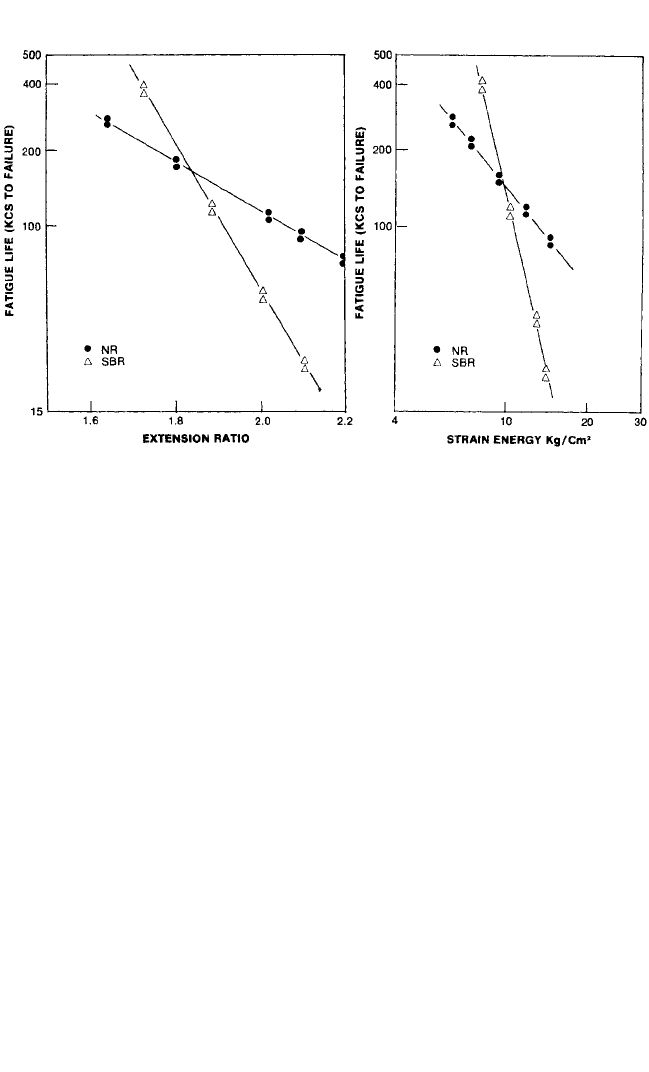
Mechanical fractures occur when a rubber part is subjected to a cyclic stress or
strain.The initial crack usually originates in an area of high stress concentration and
grows until complete fracture occurs. Both the time until initial crack appearance
and the growth rate increase with increasing temperature and increased stress or
strain amplitudes.
Several procedures are available for the dynamic testing of laboratory-prepared
samples. The most common is the DeMattia flex machine which can test for crack
initiation or the growth of an induced cut.
34
The Ross Flexer machine also tests for
cut growth.
35
Although the data can be used for relative comparisons, all of these
procedures show poor correlation with product performance. Dynamic fatigue test-
ing is therefore frequently performed on the actual part. Because of time con-
straints, the applied energy input (cyclic stress and strain amplitudes) is increased to
much larger values than what the part experiences in actual service. The effect of
energy input on fatigue life is shown in Fig. 33.9.
36
At low-energy input the SBR com-
pound has better fatigue resistance than the NR compound. However, when the
strain and resulting input energy is increased, the curves cross over, and the NR
compound has the better fatigue resistance.
37
Therefore, caution must be exercised
when interpreting such data.
Reinforcing fillers and vulcanization systems also have definite effects on fatigue
properties.
38
Smaller particle-size carbon blacks typically give increased reinforce-
ment and improved fatigue resistance. Vulcanization systems that produce high lev-
els of polysulfide crosslinks give optimum fatigue resistance.
33.16 CHAPTER THIRTY-THREE
FIGURE 33.9 Fatigue curves of carbon-black-filled natural rubber and SBR plotted as a function
of extension ratio (A) and strain energy (B). (After Babbit.
36
)
(B)(A)
8434_Harris_33_b.qxd 09/20/2001 12:30 PM Page 33.16

REFERENCES
The following references designated by ASTM D, followed by a number, are publi-
cations of the American Society for Testing and Materials, 1916 Race Street,
Philadelphia, PA 19103.
1. Morton, M.: “Rubber Technology,” Van Nostrand Reinhold, New York, 1987.
2. Donnet, J., A. Voet: “Carbon Black—Physics, Chemistry, and Elastomer Reinforcement,”
Marcel Dekker, New York, 1976.
3. Eirich, F. R., and A. Y. Coran: “Science and Technology of Rubber,” Academic Press, New
York, 1994.
4. Long, H.: “Basic Compounding and Processing of Rubber,” Lancaster Press, Lancaster,
Pa., 1985.
5. ASTM D412
6. Brown, R. P.:“Physical Testing of Rubber,” Elsevier Applied Science Publishers, New York,
1986.
7. ASTM D2240
8. ASTM D531
9. ASTM D412
10. ASTM D624
11. ASTM D395, Method B
12. ASTM D395, Method A
13. ASTM D429, Method B
14. ASTM D429, Method 429
15. ASTM D1053
16. Gehman, S. D., D. E. Woodford, and C. S.Wilkinson: Ind. Eng. Chem., 39:1108 (1947).
17. ASTM D797
18. ASTM D573
19. ASTM D471
20. Edwards, D. C., E. B. Storey: Trans. Inst. Rubber Ind., 31, 45 (1955).
21. ASTM D 1149
22. ASTM D3395
23. Schaefer, R. J.: Rubber World, May, July, Sept., Nov. (1994) and Jan., March, May (1995)
24. ASTM D1054
25. ASTM D2632
26. ASTM D945
27. ASTM D2231
28. Medalia, A. I.: Rubber Chem. and Tech., 51, 437 (1978).
29. Edwards, R. C.: Automotive Elastomers and Design, March 3, 1983.
30. Freakley, P. K., A. R. Payne: “Theory and Practice of Engineering with Rubber,” Applied
Science Publishers, London, 1970.
31. Gent, A. N., “How to Design Rubber Components,” Hanser Publishers, New York, 1994.
32. Corsaro, R. D., and L. H. Sperling: “Sound and Vibration Damping with Polymers,” Amer-
ican Chemical Society, Washington, D.C., 1990.
33. Morron, J. D.: ASME Paper 46-SA-18, presented June 1946.
34. ASTM D430
35. ASTM D1052
MECHANICAL PROPERTIES OF RUBBER 33.17
8434_Harris_33_b.qxd 09/20/2001 12:30 PM Page 33.17
